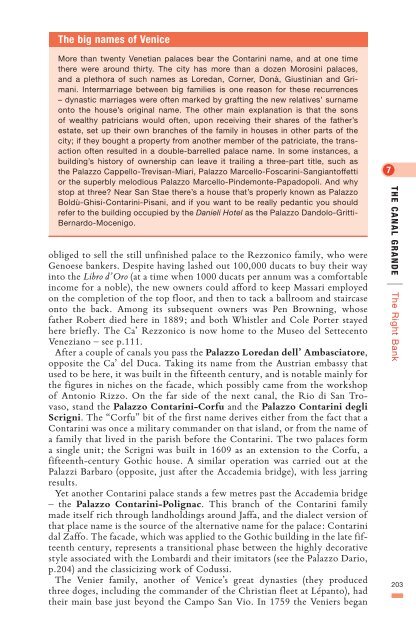Create successful ePaper yourself
Turn your PDF publications into a flip-book with our unique Google optimized e-Paper software.
<strong>The</strong> big names of <strong>Venice</strong><br />
More than twenty Venetian palaces bear <strong>the</strong> Contarini name, <strong>and</strong> at one time<br />
<strong>the</strong>re were around thirty. <strong>The</strong> city has more than a dozen Morosini palaces,<br />
<strong>and</strong> a plethora of such names as Loredan, Corner, Donà, Giustinian <strong>and</strong> Grimani.<br />
Intermarriage between big families is one reason for <strong>the</strong>se recurrences<br />
– dynastic marriages were often marked by grafting <strong>the</strong> new relatives’ surname<br />
on<strong>to</strong> <strong>the</strong> house’s original name. <strong>The</strong> o<strong>the</strong>r main explanation is that <strong>the</strong> sons<br />
of wealthy patricians would often, upon receiving <strong>the</strong>ir shares of <strong>the</strong> fa<strong>the</strong>r’s<br />
estate, set up <strong>the</strong>ir own branches of <strong>the</strong> family in houses in o<strong>the</strong>r parts of <strong>the</strong><br />
city; if <strong>the</strong>y bought a property from ano<strong>the</strong>r member of <strong>the</strong> patriciate, <strong>the</strong> transaction<br />
often resulted in a double-barrelled palace name. In some instances, a<br />
building’s his<strong>to</strong>ry of ownership can leave it trailing a three-part title, such as<br />
<strong>the</strong> Palazzo Cappello-Trevisan-Miari, Palazzo Marcello-Foscarini-Sangian<strong>to</strong>ffetti<br />
or <strong>the</strong> superbly melodious Palazzo Marcello-Pindemonte-Papadopoli. And why<br />
s<strong>to</strong>p at three Near San Stae <strong>the</strong>re’s a house that’s properly known as Palazzo<br />
Boldù-Ghisi-Contarini-Pisani, <strong>and</strong> if you want <strong>to</strong> be really pedantic you should<br />
refer <strong>to</strong> <strong>the</strong> building occupied by <strong>the</strong> Danieli Hotel as <strong>the</strong> Palazzo D<strong>and</strong>olo-Gritti-<br />
Bernardo-Mocenigo.<br />
obliged <strong>to</strong> sell <strong>the</strong> still unfinished palace <strong>to</strong> <strong>the</strong> Rezzonico family, who were<br />
Genoese bankers. Despite having lashed out 100,000 ducats <strong>to</strong> buy <strong>the</strong>ir way<br />
in<strong>to</strong> <strong>the</strong> Libro d’Oro (at a time when 1000 ducats per annum was a comfortable<br />
income for a noble), <strong>the</strong> new owners could afford <strong>to</strong> keep Massari employed<br />
on <strong>the</strong> completion of <strong>the</strong> <strong>to</strong>p floor, <strong>and</strong> <strong>the</strong>n <strong>to</strong> tack a ballroom <strong>and</strong> staircase<br />
on<strong>to</strong> <strong>the</strong> back. Among its subsequent owners was Pen Browning, whose<br />
fa<strong>the</strong>r Robert died here in 1889; <strong>and</strong> both Whistler <strong>and</strong> Cole Porter stayed<br />
here briefly. <strong>The</strong> Ca’ Rezzonico is now home <strong>to</strong> <strong>the</strong> Museo del Settecen<strong>to</strong><br />
Veneziano – see p.111.<br />
After a couple of canals you pass <strong>the</strong> Palazzo Loredan dell’ Ambascia<strong>to</strong>re,<br />
opposite <strong>the</strong> Ca’ del Duca. Taking its name from <strong>the</strong> Austrian embassy that<br />
used <strong>to</strong> be here, it was built in <strong>the</strong> fifteenth century, <strong>and</strong> is notable mainly for<br />
<strong>the</strong> figures in niches on <strong>the</strong> facade, which possibly came from <strong>the</strong> workshop<br />
of An<strong>to</strong>nio Rizzo. On <strong>the</strong> far side of <strong>the</strong> next canal, <strong>the</strong> Rio di San Trovaso,<br />
st<strong>and</strong> <strong>the</strong> Palazzo Contarini-Corfu <strong>and</strong> <strong>the</strong> Palazzo Contarini degli<br />
Scrigni. <strong>The</strong> “Corfu” bit of <strong>the</strong> first name derives ei<strong>the</strong>r from <strong>the</strong> fact that a<br />
Contarini was once a military comm<strong>and</strong>er on that isl<strong>and</strong>, or from <strong>the</strong> name of<br />
a family that lived in <strong>the</strong> parish before <strong>the</strong> Contarini. <strong>The</strong> two palaces form<br />
a single unit; <strong>the</strong> Scrigni was built in 1609 as an extension <strong>to</strong> <strong>the</strong> Corfu, a<br />
fifteenth-century Gothic house. A similar operation was carried out at <strong>the</strong><br />
Palazzi Barbaro (opposite, just after <strong>the</strong> Accademia bridge), with less jarring<br />
results.<br />
Yet ano<strong>the</strong>r Contarini palace st<strong>and</strong>s a few metres past <strong>the</strong> Accademia bridge<br />
– <strong>the</strong> Palazzo Contarini-Polignac. This branch of <strong>the</strong> Contarini family<br />
made itself rich through l<strong>and</strong>holdings around Jaffa, <strong>and</strong> <strong>the</strong> dialect version of<br />
that place name is <strong>the</strong> source of <strong>the</strong> alternative name for <strong>the</strong> palace: Contarini<br />
dal Zaffo. <strong>The</strong> facade, which was applied <strong>to</strong> <strong>the</strong> Gothic building in <strong>the</strong> late fifteenth<br />
century, represents a transitional phase between <strong>the</strong> highly decorative<br />
style associated with <strong>the</strong> Lombardi <strong>and</strong> <strong>the</strong>ir imita<strong>to</strong>rs (see <strong>the</strong> Palazzo Dario,<br />
p.204) <strong>and</strong> <strong>the</strong> classicizing work of Codussi.<br />
<strong>The</strong> Venier family, ano<strong>the</strong>r of <strong>Venice</strong>’s great dynasties (<strong>the</strong>y produced<br />
three doges, including <strong>the</strong> comm<strong>and</strong>er of <strong>the</strong> Christian fleet at Lépan<strong>to</strong>), had<br />
<strong>the</strong>ir main base just beyond <strong>the</strong> Campo San Vio. In 1759 <strong>the</strong> Veniers began<br />
<strong>the</strong> canal gr<strong>and</strong>e<br />
|<br />
<strong>The</strong> Right Bank<br />
203







